Abstract
Growth of Neisseria gonorrhoeae from clinical specimens has been enhanced by the use of selective media that inhibit the simultaneous growth of other microorganisms. One explanation for this enhancement could be that certain other bacteria inhibit gonococcal growth. This hypothesis was examined by testing 167 bacterial isolates for in vitro gonococcal inhibition; 34.1% of the isolates failed to inhibit the gonococcus, but 12.0% produced weak inhibition and 53.9% strongly inhibited N. gonorrhoeae. The pattern of in vitro gonococcal inhibition was consistently the same for all the individual isolates within some species, but individual isolates within other bacterial species varied in their ability to inhibit the gonococcus. Consistently strong in vitro N. gonorrhoeae inhibitors were Citrobacter diversus, Enterobacter cloacae, Serratia marcescens, and Pseudomonas. The in vivo significance of gonococcal interference was demonstrated in the subcutaneous chamber model of N. gonorrhoeae infection.
Full text
PDF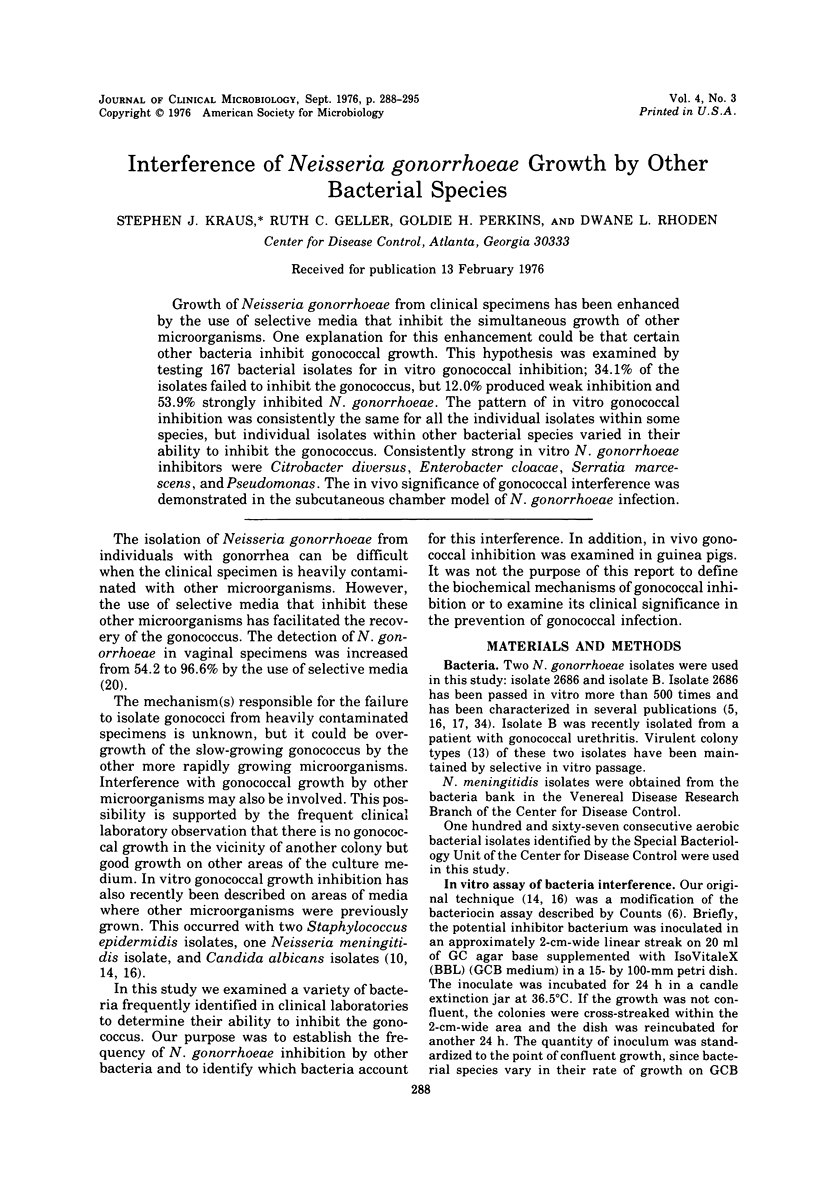
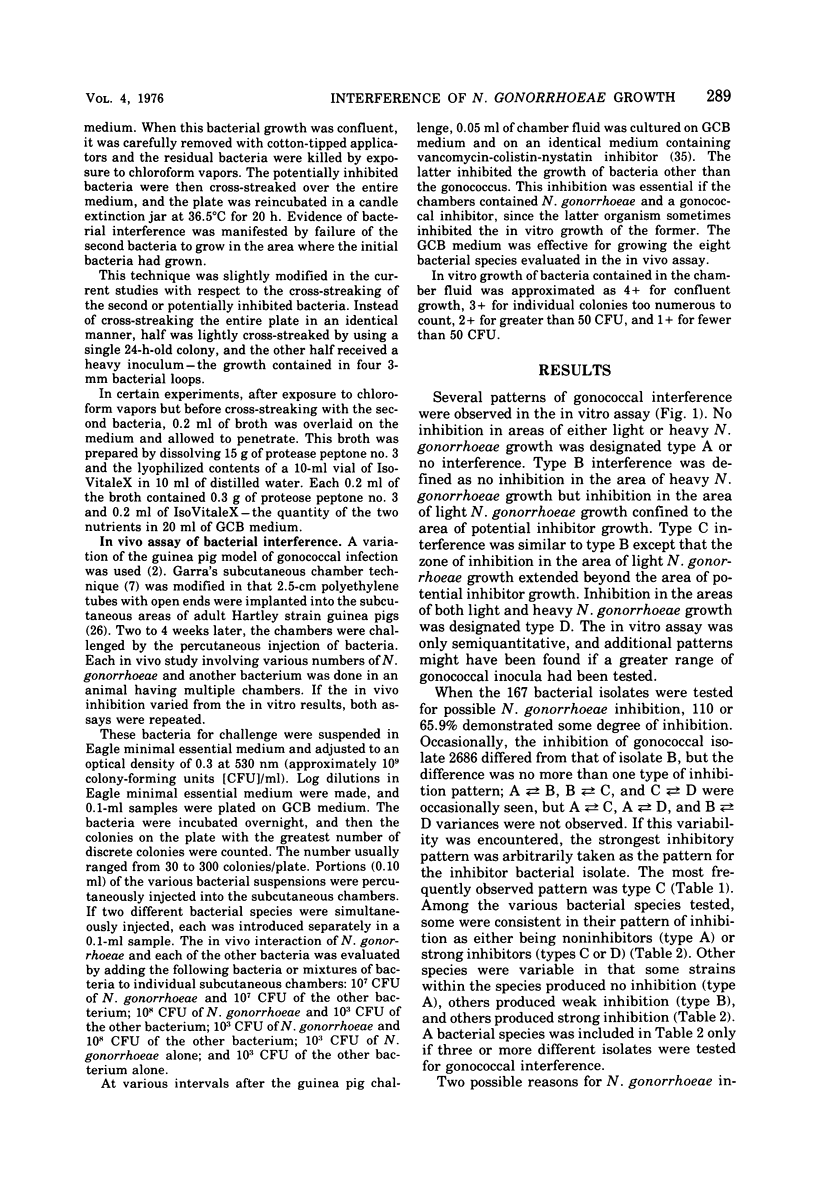
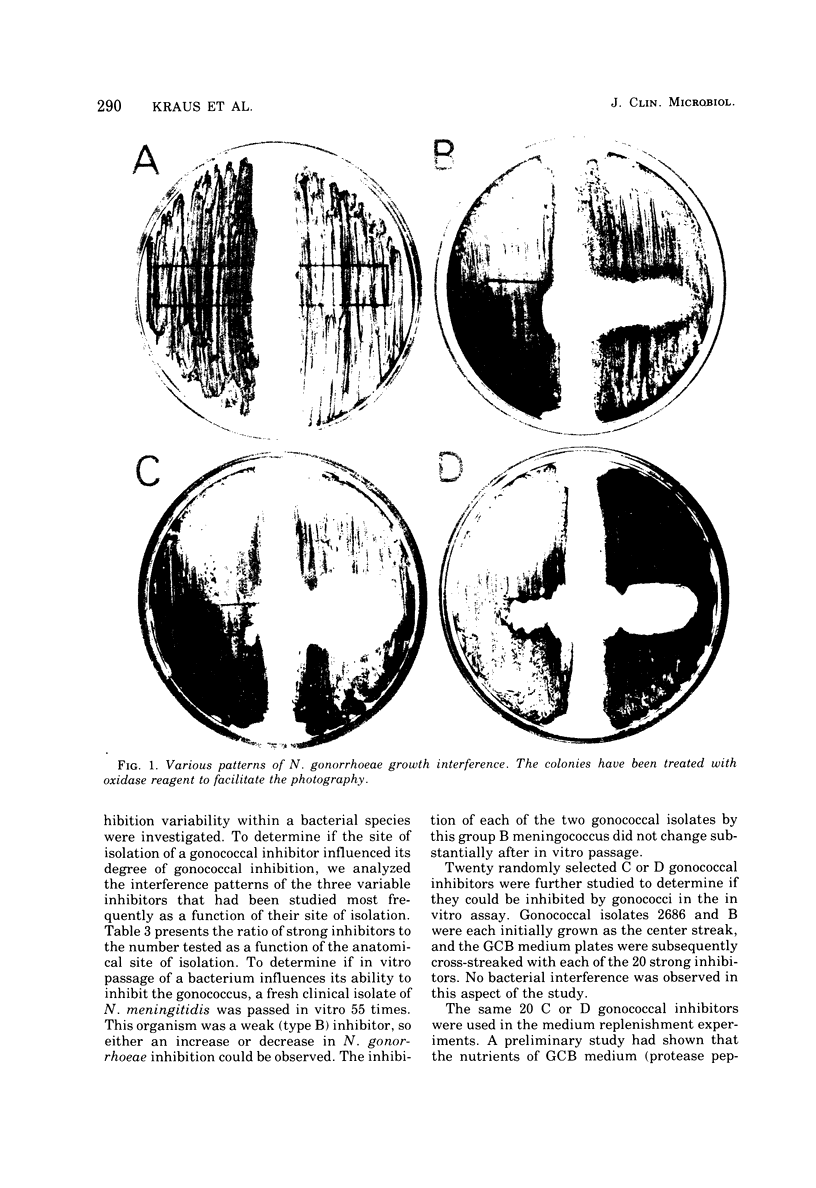
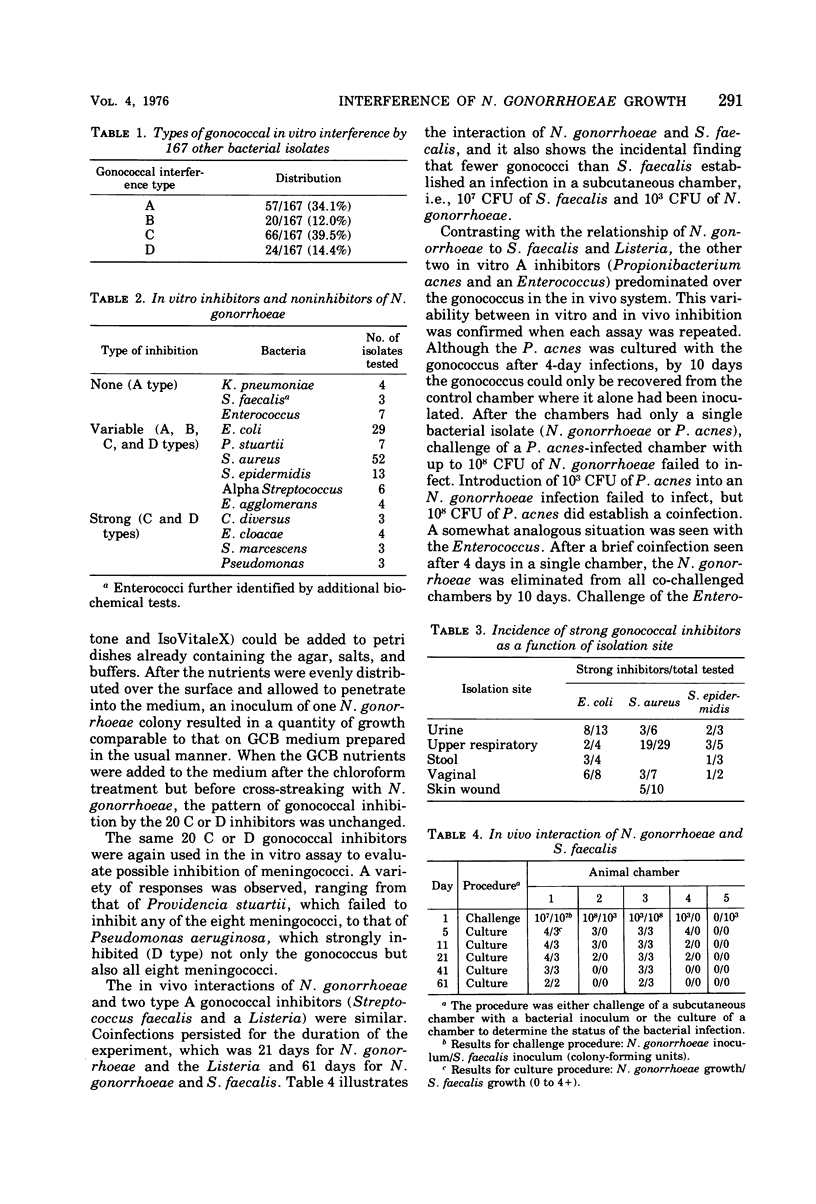
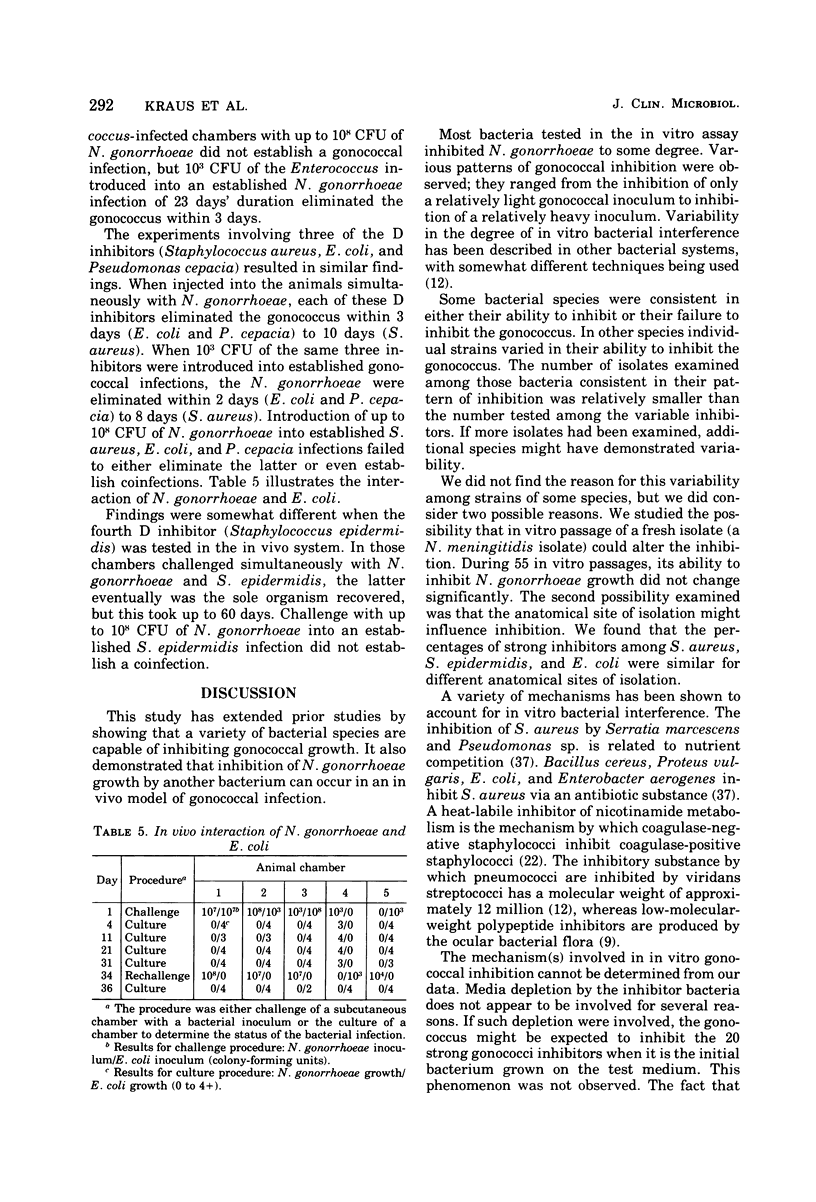
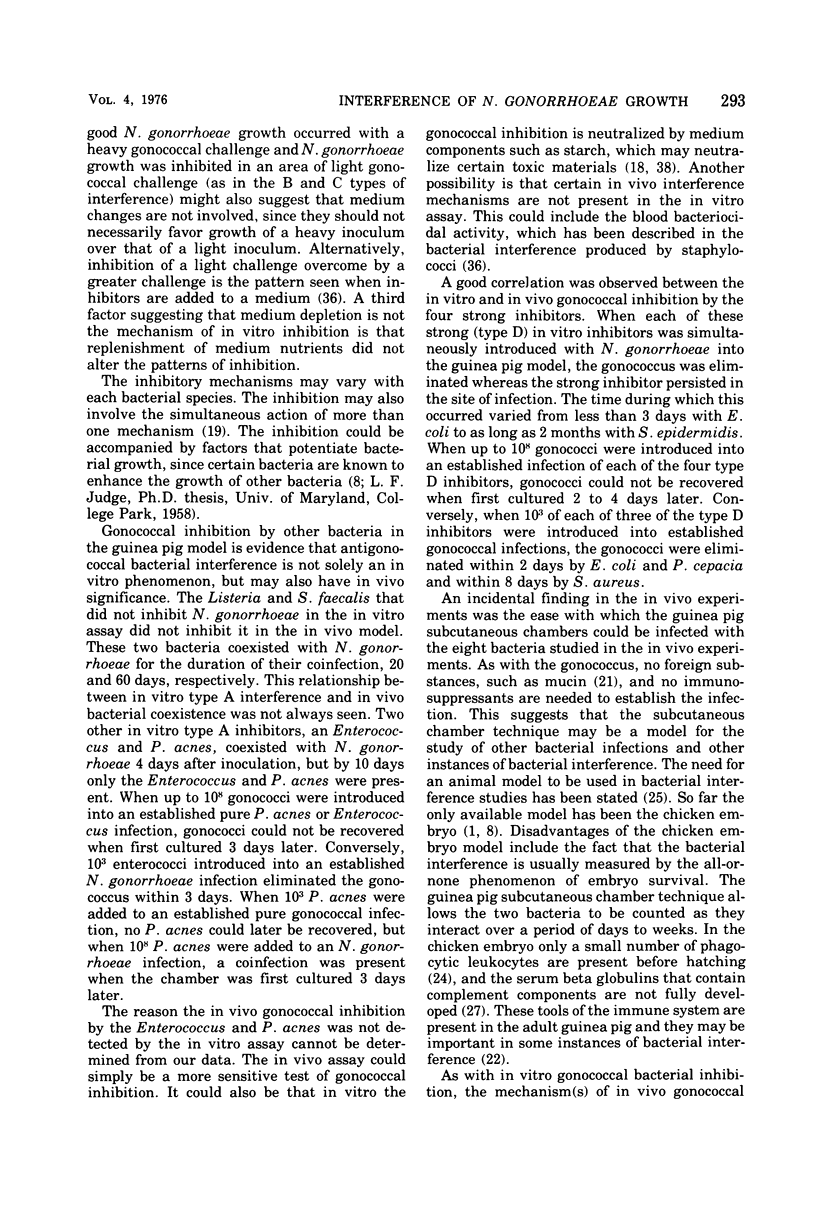
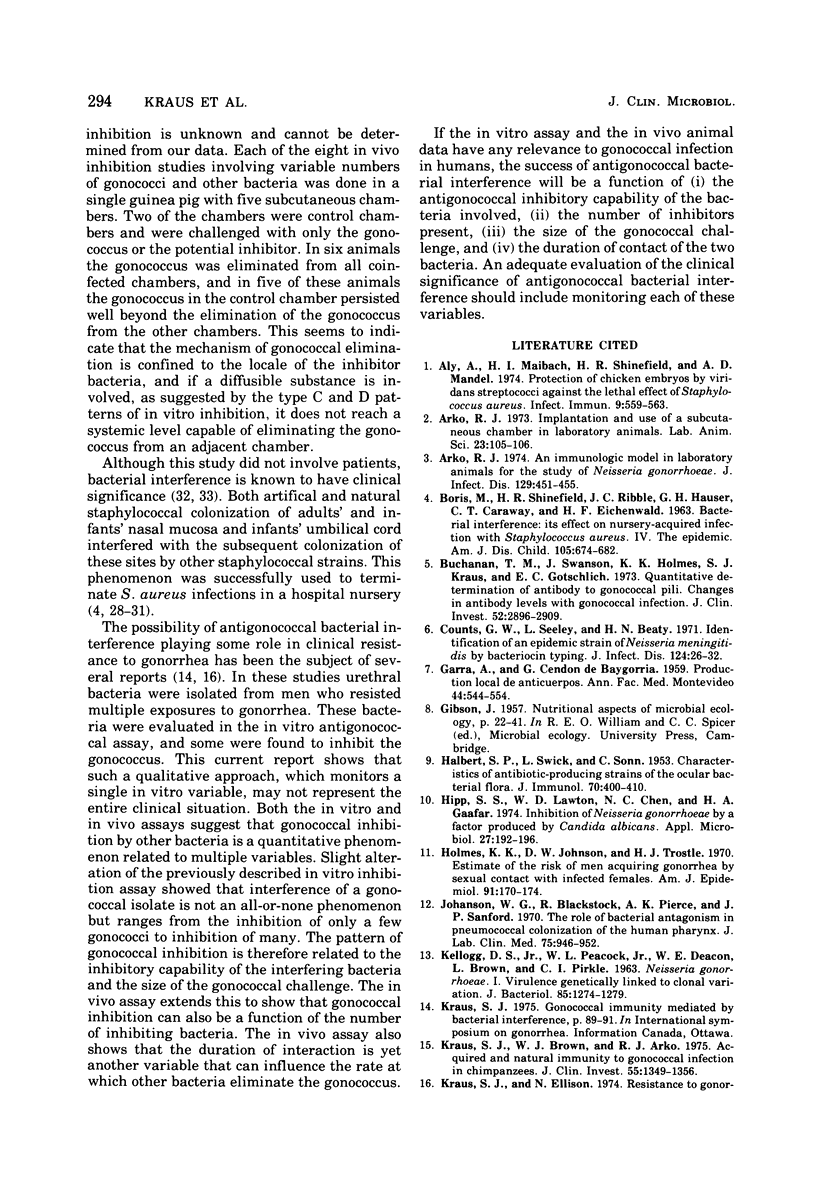
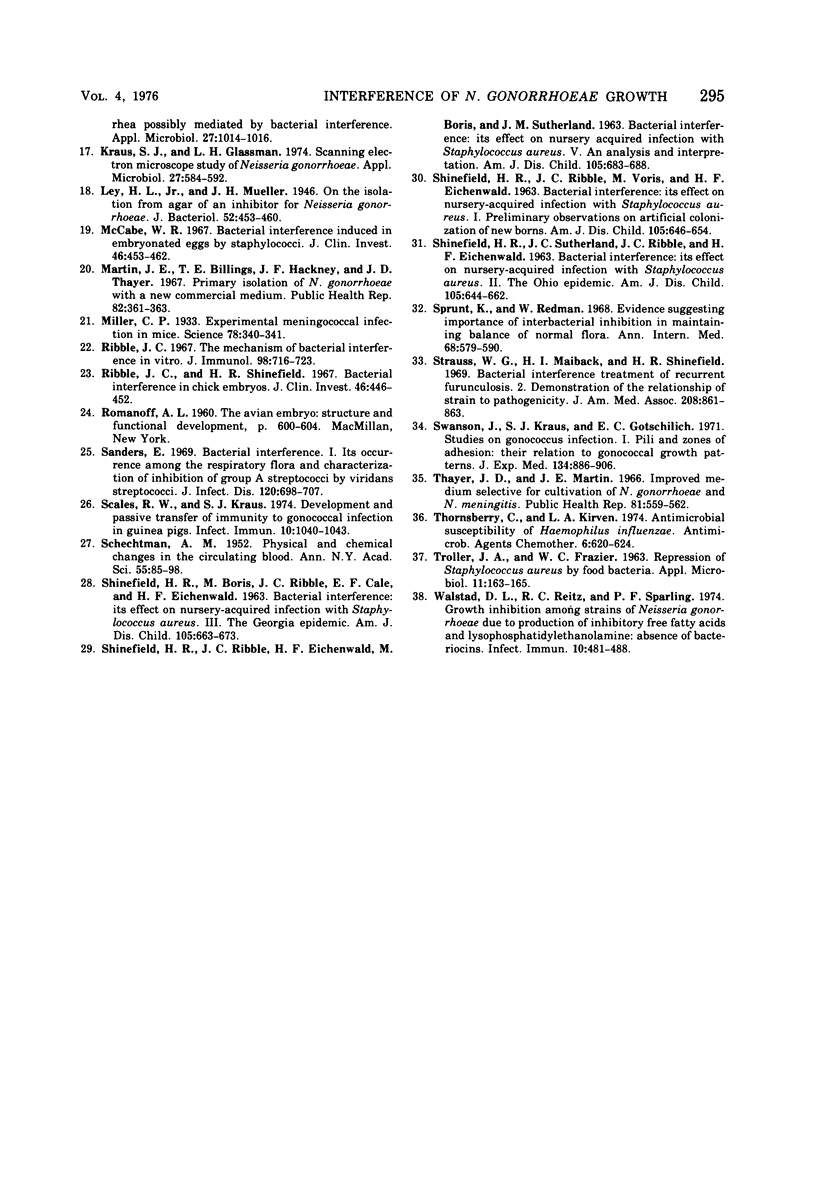
Images in this article
Selected References
These references are in PubMed. This may not be the complete list of references from this article.
- Aly R., Maibach H. I., Shinefield H. R., Mandel A. D. Protection of chicken embryos by viridans streptococci against the lethal effect of Staphylococcus aureus. Infect Immun. 1974 Mar;9(3):559–563. doi: 10.1128/iai.9.3.559-563.1974. [DOI] [PMC free article] [PubMed] [Google Scholar]
- Arko R. J. An immunologic model in laboratory animals for the study of Neisseria gonorrhoeae. J Infect Dis. 1974 Apr;129(4):451–455. doi: 10.1093/infdis/129.4.451. [DOI] [PubMed] [Google Scholar]
- Arko R. J. Implantation and use of a subcutaneous culture chamber in laboratory animals. Lab Anim Sci. 1973 Feb;23(1):105–106. [PubMed] [Google Scholar]
- BORIS M., SHINE FIELD H. R., RIBBLE J. C., EICHENWALD H. F., HAUSER G. H., CARAWAY C. T. Bacterial interference: its effect on nursery-acquired infection with Staphylococcus aureus. IV. The Louisiana epidemic. Am J Dis Child. 1963 Jun;105:674–682. [PubMed] [Google Scholar]
- Buchanan T. M., Swanson J., Holmes K. K., Kraus S. J., Gotschlich E. C. Quantitative determination of antibody to gonococcal pili. Changes in antibody levels with gonococcal infection. J Clin Invest. 1973 Nov;52(11):2896–2909. doi: 10.1172/JCI107486. [DOI] [PMC free article] [PubMed] [Google Scholar]
- Counts G. W., Seeley L., Beaty H. N. Identification of an epidemic strain of Neisseria meningitidis by bacteriocin typing. J Infect Dis. 1971 Jul;124(1):26–32. doi: 10.1093/infdis/124.1.26. [DOI] [PubMed] [Google Scholar]
- GARRA A., CENDON DE BAYGORRIA G. [Local production of antibodies]. An Fac Med Univ Repub Montev Urug. 1959;44:544–547. [PubMed] [Google Scholar]
- HALBERT S. P., SWICK L., SONN C. Characteristics of antibiotic-producing strains of the ocular bacterial flora. J Immunol. 1953 Apr;70(4):400–410. [PubMed] [Google Scholar]
- Hipp S. S., Lawton W. D., Chen N. C., Gaafar H. A. Inhibition of Neisseria gonorrhoeae by a factor produced by Candida albicans. Appl Microbiol. 1974 Jan;27(1):192–196. doi: 10.1128/am.27.1.192-196.1974. [DOI] [PMC free article] [PubMed] [Google Scholar]
- Holmes K. K., Johnson D. W., Trostle H. J. An estimate of the risk of men acquiring gonorrhea by sexual contact with infected females. Am J Epidemiol. 1970 Feb;91(2):170–174. doi: 10.1093/oxfordjournals.aje.a121125. [DOI] [PubMed] [Google Scholar]
- Johanson W. G., Jr, Blackstock R., Pierce A. K., Sanford J. P. The role of bacterial antagonism in pneumococcal colonization of the human pharynx. J Lab Clin Med. 1970 Jun;75(6):946–952. [PubMed] [Google Scholar]
- KELLOGG D. S., Jr, PEACOCK W. L., Jr, DEACON W. E., BROWN L., PIRKLE D. I. NEISSERIA GONORRHOEAE. I. VIRULENCE GENETICALLY LINKED TO CLONAL VARIATION. J Bacteriol. 1963 Jun;85:1274–1279. doi: 10.1128/jb.85.6.1274-1279.1963. [DOI] [PMC free article] [PubMed] [Google Scholar]
- Kraus S. J., Brown W. J., Arko R. J. Acquired and natural immunity to gonococcal infection in chimpanzees. J Clin Invest. 1975 Jun;55(6):1349–1356. doi: 10.1172/JCI108054. [DOI] [PMC free article] [PubMed] [Google Scholar]
- Kraus S. J., Ellison N. Resistance to gonorrhea possibly mediated by bacterial interference. Appl Microbiol. 1974 Jun;27(6):1014–1016. doi: 10.1128/am.27.6.1014-1016.1974. [DOI] [PMC free article] [PubMed] [Google Scholar]
- Kraus S. J., Glassman L. H. Scanning electron microscope study of Neisseria gonorrhoeae. Appl Microbiol. 1974 Mar;27(3):584–592. doi: 10.1128/am.27.3.584-592.1974. [DOI] [PMC free article] [PubMed] [Google Scholar]
- Ley H. L., Jr, Mueller J. H. On the Isolation from Agar of an Inhibitor for Neisseria gonorrhoeae. J Bacteriol. 1946 Oct;52(4):453–460. doi: 10.1128/jb.52.4.453-460.1946. [DOI] [PMC free article] [PubMed] [Google Scholar]
- Martin J. E., Jr, Billings T. E., Hackney J. F., Thayer J. D. Primary isolation of N. gonorrhoeae with a new commercial medium. Public Health Rep. 1967 Apr;82(4):361–363. [PMC free article] [PubMed] [Google Scholar]
- McCabe W. R. Bacterial interference induced in embryonated eggs by staphylococci. J Clin Invest. 1967 Mar;46(3):453–462. doi: 10.1172/JCI105547. [DOI] [PMC free article] [PubMed] [Google Scholar]
- Miller C. P. EXPERIMENTAL MENINGOCOCCAL INFECTION IN MICE. Science. 1933 Oct 13;78(2024):340–341. doi: 10.1126/science.78.2024.340. [DOI] [PubMed] [Google Scholar]
- Ribble J. C. A mechanism of bacterial interference in vitro. J Immunol. 1967 Apr;98(4):716–723. [PubMed] [Google Scholar]
- Ribble J. C., Shinefield H. R. Bacterial interference in chick embryos. J Clin Invest. 1967 Mar;46(3):446–452. doi: 10.1172/JCI105546. [DOI] [PMC free article] [PubMed] [Google Scholar]
- SCHECHTMAN A. M. Physical and chemical changes in the circulating blood. Ann N Y Acad Sci. 1952 Aug 8;55(2):85–98. doi: 10.1111/j.1749-6632.1952.tb26524.x. [DOI] [PubMed] [Google Scholar]
- SHINEFIELD H. R., BORIS M., RIBBLE J. C., CALE E. F., EICHENWALD H. F. Bacterial interference: its effect on nursery-acquired infection with Staphylococcus aureus. III. The Georgia epidemic. Am J Dis Child. 1963 Jun;105:663–673. [PubMed] [Google Scholar]
- SHINEFIELD H. R., RIBBLE J. C., BORIS M., EICHENWALD H. F. Bacterial interference: its effect on nursery-acquired infection with Staphylococcus aureus. I. Preliminary observations on artificial colonzation of newborns. Am J Dis Child. 1963 Jun;105:646–654. [PubMed] [Google Scholar]
- SHINEFIELD H. R., RIBBLE J. C., EICHENWALD H. F., BORIS M., SUTHERLAND J. M. Bacterial interference: its effect on nursery-acquired infection with Staphylococcus aureus. V. An analysis and interpretation. Am J Dis Child. 1963 Jun;105:683–688. [PubMed] [Google Scholar]
- SHINEFIELD H. R., SUTHERLAND J. M., RIBBLE J. C., EICHENWALD H. F. Bacterial interference: its effect on nursery-acquired infection with Staphylococcus aureus. II. The Ohio epidemic. Am J Dis Child. 1963 Jun;105:655–662. [PubMed] [Google Scholar]
- Sanders E. Bacterial interference. I. Its occurrence among the respiratory tract flora and characterization of inhibition of group A streptococci by viridans streptococci. J Infect Dis. 1969 Dec;120(6):698–707. doi: 10.1093/infdis/120.6.698. [DOI] [PubMed] [Google Scholar]
- Scales R. W., Kraus S. J. Development and passive transfer of immunity to gonococcal infection in Guinea pigs. Infect Immun. 1974 Nov;10(5):1040–1043. doi: 10.1128/iai.10.5.1040-1043.1974. [DOI] [PMC free article] [PubMed] [Google Scholar]
- Sprunt K., Redman W. Evidence suggesting importance of role of interbacterial inhibition in maintaining balance of normal flora. Ann Intern Med. 1968 Mar;68(3):579–590. doi: 10.7326/0003-4819-68-3-579. [DOI] [PubMed] [Google Scholar]
- Strauss W. G., Maibach H. I., Shinefield H. R. Bacterial interference treatment of recurrent furunculosis. 2. Demonstration of the relationship of strain to pathogeneicity. JAMA. 1969 May 5;208(5):861–863. [PubMed] [Google Scholar]
- Swanson J., Kraus S. J., Gotschlich E. C. Studies on gonococcus infection. I. Pili and zones of adhesion: their relation to gonococcal growth patterns. J Exp Med. 1971 Oct 1;134(4):886–906. doi: 10.1084/jem.134.4.886. [DOI] [PMC free article] [PubMed] [Google Scholar]
- TROLLER J. A., FRAZIER W. C. Repression of Staphylococcus aureus by food bacteria. II. Causes of inhibition. Appl Microbiol. 1963 Mar;11:163–165. doi: 10.1128/am.11.2.163-165.1963. [DOI] [PMC free article] [PubMed] [Google Scholar]
- Thayer J. D., Martin J. E., Jr Improved medium selective for cultivation of N. gonorrhoeae and N. meningitidis. Public Health Rep. 1966 Jun;81(6):559–562. [PMC free article] [PubMed] [Google Scholar]
- Thornsberry C., Kirven L. A. Antimicrobial susceptibility of Haemophilus influenzae. Antimicrob Agents Chemother. 1974 Nov;6(5):620–624. doi: 10.1128/aac.6.5.620. [DOI] [PMC free article] [PubMed] [Google Scholar]
- Walstad D. L., Reitz R. C., Sparling P. F. Growth inhibition among strains of Neisseria gonorrhoeae due to production of inhibitory free fatty acids and lysophosphatidylethanolamine: absence of bacteriocins. Infect Immun. 1974 Sep;10(3):481–488. doi: 10.1128/iai.10.3.481-488.1974. [DOI] [PMC free article] [PubMed] [Google Scholar]



